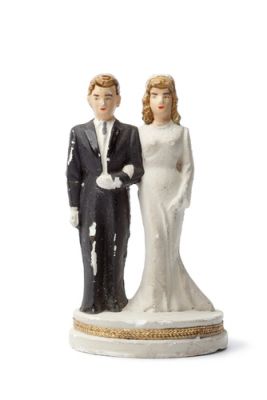 As you and your future spouse decide what sort of delectable sweet treat you’ll offer to your wedding guests, you’ll probably encounter some typical traditions involving wedding cake. There’s a reason behind each one, usually rooted in older social norms and customs. If you’ve ever wondered why the happy couple feeds each other cake, saves the top layer for their one-year anniversary, or has a bride and groom cake topper, read on. You may learn some surprising things.
As you and your future spouse decide what sort of delectable sweet treat you’ll offer to your wedding guests, you’ll probably encounter some typical traditions involving wedding cake. There’s a reason behind each one, usually rooted in older social norms and customs. If you’ve ever wondered why the happy couple feeds each other cake, saves the top layer for their one-year anniversary, or has a bride and groom cake topper, read on. You may learn some surprising things.
The Origins of Wedding Cakes
Most modern wedding cakes trace their roots to medieval, Renaissance, or Enlightenment-era Europe. During the Middle Ages, tradition held that newlyweds should attempt to kiss each other over these multitiered stacks of goodness. Three-layered marzipan and icing varieties became favorites for weddings in both England and colonial America, and the white-frosted towers we’ve come to know today originated during the Victorian period. Croquembouches, or tall stacks of cream puffs covered in spun sugar, fruit, chocolate, or sugared almonds, became popular after their invention by French pastry chef Marie-Antoine Carême in the late 1700s.
Where Did Cake Toppers Come From?
Prior to the American Civil War, these wedding confections were usually decorated with flowers or edibles such as fruit, chocolate, and sugary designs. One wedding history blogger, Donna Sundblad, states that cake toppers became popular during the Civil War and were in common usage by the 1890s. The first versions included simple designs with bells, bows, or monogrammed initials. By the 1950s, cake topper figurines of newly married couples were a common sight at weddings.
The 411 on Cake Cutting Customs
The Knot explains that the bride originally cut the cake on her own, observing the tradition to ensure that her new union would produce children. In modern times, the couple usually cuts the first slices together, with each spouse feeding a portion to the other. That moment can be tender and loving, comical, or disrespectful, depending on how it’s executed. The Knot writer Sophie Ross points out that cake smashing can lead to ruined makeup and hair, messy clothes, and a breach of trust. Keep in mind that the sweet, gentle act of simply feeding each other can set the tone for the rest of your relationship. On the other hand, the moment can be funny and memorable if you both agree to smear a bit of frosting on each other’s noses or go in for a full-on smash. Whatever you decide to do, you must arrive at a consensus before the big day.
What About Saving the Top Layer?
Many couples choose to save the top tier of their wedding cakes to enjoy on their first anniversary. Brides contributor Erin Celletti ties the cake itself to hopes for good fortune and prosperity, then mentions that newlyweds of yesteryear stored the cake away to eat when their first child was christened. While in modern times there’s less of a connection between consuming leftover wedding cake and celebrating the arrival of a firstborn, some still follow the tradition of preserving and consuming the upper tier. If you’d like to enjoy your cake next year, you have a couple of options:
- Transport the layer home, then cover it with plastic wrap, place it in a cake box, and wrap the entire cake box before placing in the freezer.
- Ask your baker to remake the top layer before your anniversary date, following your cake’s original specs.
Wedding cakes are far more than just grand desserts for special events. As symbols of hope for a prosperous future together, it’s no wonder that so many details go into creating and serving them. Delving into the history of wedding cake customs can be a fascinating experience that expands your appreciation of these sweet delicacies.
Add Your Comment